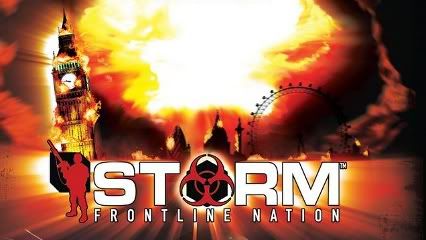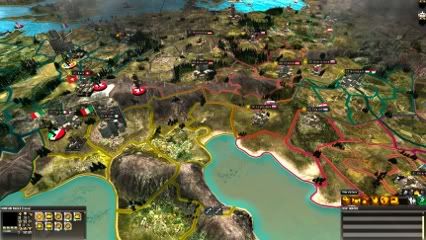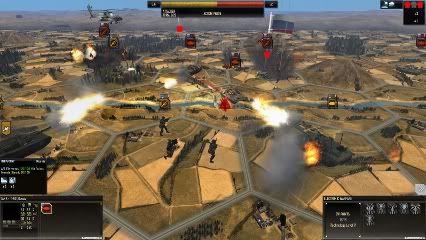 Format: PC
Format: PC- Unleashed: Out Now
- Publisher: Just A Game
- Developer: Colossai Studios
- Players: 1 – 4
- Site: http://stormfrontlinenation.com
If the initial difficulty curve of STORM: Frontline Nation was a hill, you would struggle to climb it. The gentle slope that starts the incline soon becomes a steep face that requires you to break out the crampons. After a struggle to the top of this initial cliff the path ahead looks long and daunting, lined with the unmarked graves of casual RTS players and rotting piles of metaphoric mountain goats. STORM: Frontline Nation is hard to get a grip on, and it has no intention of helping you.
Jumping straight into the game is problematic because there is no hand holding. Story mode objectives start off simple enough; it’s mainly move this here or attack there. Unfortunately there is a complete lack of interactive tutorial. If you haven’t played a turn-based strategy game before then you’re going to be up the creek without a paddle, boat or your legs. Even if you are a veteran on the Civilization games, the lack of information about simple mechanics seems like an astonishing oversight.

For a world divided by colourful borders there sure is a lot of war...
Hidden in the pause menu is a series of tutorial videos, but these only help you to a very minor extent and might require multiple viewings until you grasp each concept. These aren’t helped by the fact they are presented as a text based guide on top of a minimised game interface that is hard to see. The entire thing is delivered with the charisma of a sad cow waiting in the queue at the slaughterhouse. Even with the videos, there is a mountain of things not mentioned that are vitally important.
It took hours to figure out how to move a tank from a boat back onto land. Soldiers are more than capable of embarking and disembarking as long as there’s a bit of coast there, but tracked units struggle. Apparently ground vehicles require a port or coastal town to come ashore. There are lots of vital things like this that the game neglects to mention. It took us nine hours of play to finally grasp the majority of vital mechanics, but even then we couldn’t work out a few things, such as how to move cruise missiles onto battleships.
If your first few attempts are anything like ours, you’ll probably want to restart the campaign, or perhaps take the less severe approach and reload a previously saved position. And it’s here where we find our next disappointing surprise. There is no option in the pause menu that lets you load a previously saved game. You can choose to save the campaign whenever you like, but to jump back to it you’ll have to quit the game and return through the main menu. In a game with very little instruction and guidance, you need to experiment with the mechanics. This inability to instantly reload previous positions hampers your ability to try something new, because you can only undo it if you’re willing to endure a two to three minute waiting period.

The browny orange territory displays where this chap can move
When you finally start to build some momentum towards the peak of understanding the game, things start to look slightly better. You produce military units between turns and then move them around the regions you have under control. You’ll start off with a chunk of friendly land before you start scrapping with your immediate neighbours as you slowly attempt to dominate the world. It’s satisfying to slowly expand your turf and grow in power. More land means you can produce more units.
Attacks against hostile nations are a mix of rock, paper, scissors and tactical spam. The easiest way to win battles with the auto-attack is to overwhelm your opponent with sheer numbers. This is a trick that the AI knows well and will utilise against you. Expect to fight a gigantic blob of enemy units within one or two turns of your initial invasion. This can be a frustrating challenge to overcome, but once the doom blob is dead, the rest of the country is a breeze to conquer. It’s a very inconsistent challenge mix that makes a country either very easy, or excruciatingly difficult to take.
Speaking of hostile nations, the world in STORM: Frontline Nation is a very hostile place that is intent on burning. You’ll start each turn with messages like “Switzerland was annihilated by Italy” or “You’re now at war with Spain”. This gets really confusing at times, especially if you have done nothing to harm the aggressor nation. Fighting is inevitable and each battle gives you the choice between auto-resolve or your own involvement. If you choose the latter you’ll experience the game’s other main interface – tactical mode.

Sadly, tactical mode is nowhere near as intense as this makes it look
Taking place on a hex grid, the game becomes a Total War and chequers hybrid. Place units you have in that region on your side of the board and take it in turns to move them to adjacent hexagons with the intent to attack enemy held hexagons. Each unit has a health metre that slowly dissolves through fighting other forces. It’s basic, with the only real game changers being artillery and aircraft that can bombard from one end of the board to the other. After a few plays in tactical mode you’ll see that winning is just a numbers game, and end up resolving every battle with the auto-fight button. A skirmish mode lets you play the tactical battles outside of campaign mode, but it’s about as fun as skipping stones across your garden.
STORM: Frontline Nation doesn’t help itself by alienating the player from the offset. If you can put in the time to slowly learn all aspects of the game then you might get some fun from it, but you really need to have drained all enjoyment from the other, more established turn-based strategy titles. Strategy newbies looking to cut their teeth on a beginner’s title would do well to steer clear of this one. It won’t only cut your teeth, but force you to chew rocks until you have a basic understanding of everything it doesn’t tell you.








Comments